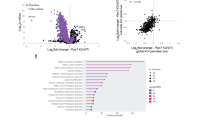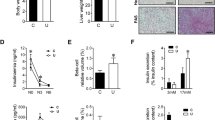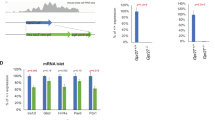Abstract
Phosphoinositide 3-kinases produce 3′-phosphorylated phosphoinositides that act as second messengers to recruit other signalling proteins to the membrane1. Pi3ks are activated by many extracellular stimuli and have been implicated in a variety of cellular responses1. The Pi3k gene family is complex and the physiological roles of different classes and isoforms are not clear. The gene Pik3r1 encodes three proteins (p85α, p55α and p50α) that serve as regulatory subunits of class IA Pi3ks (ref. 2). Mice lacking only the p85α isoform are viable but display hypoglycaemia and increased insulin sensitivity correlating with upregulation of the p55α and p50α variants3. Here we report that loss of all protein products of Pik3r1 results in perinatal lethality. We observed, among other abnormalities, extensive hepatocyte necrosis and chylous ascites. We also noted enlarged skeletal muscle fibres, brown fat necrosis and calcification of cardiac tissue. In liver and muscle, loss of the major regulatory isoform caused a great decrease in expression and activity of class IA Pi3k catalytic subunits; nevertheless, homozygous mice still displayed hypoglycaemia, lower insulin levels and increased glucose tolerance. Our findings reveal that p55α and/or p50α are required for survival, but not for development of hypoglycaemia, in mice lacking p85α.
This is a preview of subscription content, access via your institution
Access options
Subscribe to this journal
Receive 12 print issues and online access
$209.00 per year
only $17.42 per issue
Buy this article
- Purchase on Springer Link
- Instant access to full article PDF
Prices may be subject to local taxes which are calculated during checkout




Similar content being viewed by others
References
Vanhaesebroeck, B. & Waterfield, M.D. Signaling by distinct classes of phosphoinositide 3-kinases. Exp. Cell Res. 253, 239–254 (2000).
Fruman, D.A., Meyers, R.E. & Cantley, L.C. Phosphoinositide kinases. Annu. Rev. Biochem. 67, 481–507 (1998).
Terauchi, Y. et al. Increased insulin sensitivity and hypoglycaemia in mice lacking the p85 α subunit of phosphoinositide 3-kinase. Nature Genet. 21, 230–235 (1999).
Fruman, D.A., Cantley, L.C. & Carpenter, C.L. Structural organization and alternative splicing of the murine phosphoinositide 3-kinase p85 α gene. Genomics 37, 113–121 (1996).
Antonetti, D.A., Algenstaedt, P. & Kahn, C.R. Insulin receptor substrate 1 binds two novel splice variants of the regulatory subunit of phosphatidylinositol 3-kinase in muscle and brain. Mol. Cell. Biol. 16, 2195–2203 (1996).
Inukai, K. et al. p85α gene generates three isoforms of regulatory subunit for phosphatidylinositol 3-kinase (PI 3-kinase), p50α, p55α, and p85α, with different PI 3-kinase activity elevating responses to insulin. J. Biol. Chem. 272, 7873–7882 (1997).
Fruman, D.A. et al. Impaired B cell development and proliferation in absence of phosphoinositide 3-kinase p85α. Science 283, 393–397 (1999).
Beg, A.A., Sha, W.C., Bronson, R.T., Ghosh, S. & Baltimore, D. Embryonic lethality and liver degeneration in mice lacking the RelA component of NF-κ B. Nature 376, 167–170 (1995).
Li, Q., Van Antwerp, D., Mercurio, F., Lee, K.F. & Verma, I.M. Severe liver degeneration in mice lacking the IκB kinase 2 gene. Science 284, 321–325 (1999).
Folli, F. et al. Regulation of endocytic-transcytotic pathways and bile secretion by phosphatidylinositol 3-kinase in rats. Gastroenterology 113, 954–965 (1997).
Misra, S., Ujhazy, P., Gatmaitan, Z., Varticovski, L. & Arias, I.M. The role of phosphoinositide 3-kinase in taurocholate-induced trafficking of ATP-dependent canalicular transporters in rat liver. J. Biol. Chem. 273, 26638–26644 (1998).
Misra, S., Ujhazy, P., Varticovski, L. & Arias, I.M. Phosphoinositide 3-kinase lipid products regulate ATP-dependent transport by sister of P-glycoprotein and multidrug resistance associated protein 2 in bile canalicular membrane vesicles. Proc. Natl Acad. Sci. USA 96, 5814–5819 (1999).
Press, O.W., Press, N.O. & Kaufman, S.D. Evaluation and management of chylous ascites. Ann. Intern. Med. 96, 358–364 (1982).
Jiang, B.H., Zheng, J.Z. & Vogt, P.K. An essential role of phosphatidylinositol 3-kinase in myogenic differentiation. Proc. Natl Acad. Sci. USA 95, 14179–14183 (1998).
Shioi, T. et al. The conserved phosphoinositide 3-kinase pathway determines heart size in mice. EMBO J. 19, 2537–2548 (2000).
Shepherd, P.R., Withers, D.J. & Siddle, K. Phosphoinositide 3-kinase: the key switch mechanism in insulin signalling. Biochem. J. 333, 471–490 (1998).
Backer, J.M. et al. Phosphatidylinositol 3′-kinase is activated by association with IRS-1 during insulin stimulation. EMBO J. 11, 3469–3479 (1992).
Shepherd, P.R. et al. Differential regulation of phosphoinositide 3-kinase adapter subunit variants by insulin in human skeletal muscle. J. Biol. Chem. 272, 19000–19007 (1997).
Kerouz, N.J., Horsch, D., Pons, S. & Kahn, C.R. Differential regulation of insulin receptor substrates-1 and -2 (IRS-1 and IRS-2) and phosphatidylinositol 3-kinase isoforms in liver and muscle of the obese diabetic (ob/ob) mouse. J. Clin. Invest. 100, 3164–3172 (1997).
Yu, J. et al. Regulation of the p85/p110 phosphatidylinositol 3′-kinase: stabilization and inhibition of the p110α catalytic subunit by the p85 regulatory subunit. Mol. Cell. Biol. 18, 1379–1387 (1998).
Pons, S. et al. The structure and function of p55PIK reveal a new regulatory subunit for phosphatidylinositol 3-kinase. Mol. Cell. Biol. 15, 4453–4465 (1995).
Franke, T.F., Kaplan, D.R. & Cantley, L.C. PI3K: downstream AKTion blocks apoptosis. Cell 88, 435–437 (1997).
Sharma, P.M., Egawa, K., Gustafson, T.A., Martin, J.L. & Olefsky, J.M. Adenovirus-mediated overexpression of IRS-1 interacting domains abolishes insulin-stimulated mitogenesis without affecting glucose transport in 3T3-L1 adipocytes. Mol. Cell. Biol. 17, 7386–7397 (1997).
Kim, Y.B. et al. Glucosamine infusion in rats rapidly impairs insulin stimulation of phosphoinositide 3-kinase but does not alter activation of Akt/protein kinase B in skeletal muscle. Diabetes 48, 310–320 (1999).
Accili, D. et al. Early neonatal death in mice homozygous for a null allele of the insulin receptor gene. Nature Genet. 12, 106–109 (1996).
Withers, D.J. et al. Disruption of IRS-2 causes type 2 diabetes in mice. Nature 391, 900–904 (1998).
Egawa, K. et al. Membrane-targeted phosphatidylinositol 3-kinase mimics insulin actions and induces a state of cellular insulin resistance. J. Biol. Chem. 274, 14306–14314 (1999).
Carpenter, C.L. et al. Purification and characterization of phosphoinositide 3-kinase from rat liver. J. Biol. Chem. 265, 19704–19711 (1990).
Acknowledgements
We thank H. Warren and E. Meluleni for help with necropsy and histopathology; J. Alvarez for lipid analysis; M. White for the anti-p55γ antibody; T. Roberts for the anti-pTyr antibody; and I. Arias, S. Snapper, B. Sleckman, S. Thomas, M. Wahl and members of the Cantley and Kahn labs for helpful suggestions. D.A.F. was supported by fellowships from the Damon Runyan-Walter Winchell Cancer Research Fund and the Leukemia Society of America. This work was supported by NIH grants GM41890 to L.C.C. and DK55545 to C.R.K.
Author information
Authors and Affiliations
Corresponding author
Rights and permissions
About this article
Cite this article
Fruman, D., Mauvais-Jarvis, F., Pollard, D. et al. Hypoglycaemia, liver necrosis and perinatal death in mice lacking all isoforms of phosphoinositide 3-kinase p85α. Nat Genet 26, 379–382 (2000). https://doi.org/10.1038/81715
Received:
Accepted:
Issue Date:
DOI: https://doi.org/10.1038/81715
This article is cited by
-
Anthrax lethal factor cleaves regulatory subunits of phosphoinositide-3 kinase to contribute to toxin lethality
Nature Microbiology (2020)
-
Insulin–PI3K signalling: an evolutionarily insulated metabolic driver of cancer
Nature Reviews Endocrinology (2020)
-
Overexpression of PIK3R1 promotes hepatocellular carcinoma progression
Biological Research (2018)
-
Hepatic transcriptome implications for palm fruit juice deterrence of type 2 diabetes mellitus in young male Nile rats
Genes & Nutrition (2016)
-
FBXL2- and PTPL1-mediated degradation of p110-free p85β regulatory subunit controls the PI(3)K signalling cascade
Nature Cell Biology (2013)



